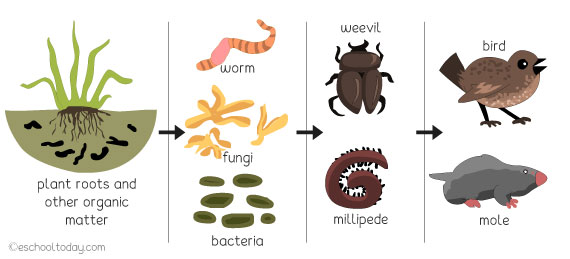- Soils
Soil Ecosystems
There are some cool ecosystems that many of us forget to mention when we talk about ecosystems. If you could turn yourself into a small soil-burrowing insect, you would be amazed by the life and interactions that go on under the surface of the soil. All the members of this wonderful ecosystem are so tiny that it is hard for the eyes to see.
Look at this illustration below. It shows a basic food web in the soil. The arrow shows the direction of energy flow.

In the soil, there are roots of plants. That is a “biotic” factor. The roots depend on nutrients, moisture, air, and temperature (abiotic factors) to survive. The roots also depend on fungi and bacteria to protect the roots from harmful bacteria attaching to it. There is also tiny organic matter existing there.
Nutrients and air are provided by tiny animals such as arthropods shredders, (weevils, millipedes, termites, and worms) that dig and turn the soils as they feed on fungi and bacteria on dead plant material. The waste (droppings) of these arthropods provide the chemicals needed for the decomposition of other organic materials.
Birds and small animals like moles also depend on mites, weevils, and insect eggs for food. Together, they all depend on moisture and air to live in the soils.
It is important that all the members of this ecosystem, together with their abiotic factors be active to ensure the survival of the ecosystem.
